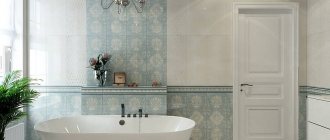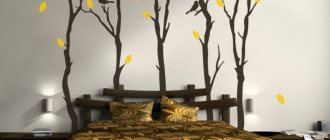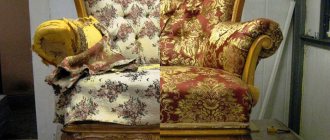Light flowing fabrics, delicate floral patterns, sophistication of vintage patina - Provençal motifs in the interior will not leave any guest in the house indifferent. Every needlewoman who likes simple but sophisticated echoes of country can make original decor in the Provence style with her own hands. Products decorated using the decoupage technique, artificially aged furniture, hand-painted kitchen utensils and soft tilde toys will help create a unique atmosphere of French comfort in the room.
The history of the Provence style
The Provencal current originates in the southeastern French province of the same name in the 15th-17th centuries.
The peculiarities of climate and nature, the way of life and mentality of local residents, and economic development have made this style recognizable far beyond the borders of its historical homeland.
The abundance of sunlight contributed to the rapid fading of bright colors, which is why soft and discreet pastel shades are so popular in the Provence style. The development of pottery also contributed to the general canons of decoration. Floral patterns, among which the rose occupied a special place, gradually became a decoration not only for ceramic products, but also for other household items.
The rough plastered walls of the houses of Provençal villages have a special charm and serve as an excellent backdrop for authentic decorative elements. Provincial simplicity and the absence of pompous gloss have made the French variety of country music universally in demand not only in country houses, but also in city apartments in modern metropolises.
Features of room design in Provence style
The interior, inspired by French country, is recognizable due to its unique distinctive features:
- Wooden or forged furniture lacks an abundance of details. The vintage appearance of the set can be emphasized with your own hands by additionally treating the surfaces;
- Pastel colors and the dominance of light shades visually make the room even more spacious. Large and uncluttered rooms are also the hallmark of the rustic style;
- Visible brick or stonework carry a special aura, immersing home owners and guests in the light and relaxed atmosphere of a picturesque village on the Cote d'Azur;
- When decorating your home, the emphasis should be on antique products: porcelain dishes, landscape paintings, vintage furniture. Linen furniture covers, homespun carpets, light curtains with floral prints and other textiles are also the main elements of the authentic French trend.
Characteristic interior items in Provence style
Artificially aged items purchased from online stores are not the best idea to imitate French country music. In the provincial home of a French family, every item has its own history: the caring hands of the owners were probably involved in its production and preservation.
Pillows
For sewing pillows, choose natural materials in pastel colors. Synthetic hypoallergenic material is used as a filler. Perfect for decorating a bedroom or living room.
Bottles
Bottles painted white are decorated using decoupage technique. They are placed on racks or filled with them on shelves in the kitchen.
Dishes
A rustic veranda or living room is not complete without a sideboard with decorative plates. Decoupage, quilling and ribbon decoration have returned to fashion. Folk crafts are gaining popularity: plates are painted using dotted, marble and stained glass techniques. Craftswomen perform paintings on clay or papier-mâché plates.
Lamps
For lampshades, textile, wicker or forged elements must be used. A decorative textile lampshade on an old copper or brass frame transforms an old, unnecessary lamp.
Decorative brick
A brick accent wall will turn from a characteristic element of the loft style into an element that satisfies the overall atmosphere of Provence if it is painted with light pastel paint.
Ideally smooth glossy surfaces, complex shapes, manufacturability and brightness of shades categorically contradict the rustic style.
Provencal style decor
Most of the decorative elements for a Provençal home interior can be made with your own hands. Master classes by experienced needlewomen allow you to learn step-by-step how to make unusual decorations that will organically fit into the decor of both a small kitchen and a spacious living room.
Textiles play a special role in the Provence style. Light translucent curtains made of cambric, satin and cotton, openwork napkins, decorative pillows decorated with embroidery, fabric kitchen accessories help to recreate the authentic style of ordinary residents of a sunny French village.
Products made of porcelain and earthenware, painted in the spirit of classic Provencal patterns, also serve as an excellent way to diversify and decorate a simple, laconic design. Opt for elegant figurines, sets with floral patterns and ceramic flower pots. In addition to the abundance of roses, images of cute cockerels, which are considered the patrons of the French province, would also be appropriate.
Window decoration in country style
Windows and their appearance play a special role in rooms whose decoration is created in the Provence style. A room stylized in the spirit of French country needs an abundance of light, so you should opt for light tulle and translucent curtains. Curtains should be decorated with unobtrusive floral patterns. An interior option in which the print of textiles is repeated with the pattern on the wallpaper will be especially advantageous.
You can decorate your curtains yourself using elegant lace and ribbons. You can decorate the bottom of the curtains with a lace frill.
Flowers placed in authentic ceramic pots will help to organically diversify the decoration of the room. Not only the usual indoor plants will remind you of your closeness to nature. Emerald basil bushes, delicate lavender or fragrant rosemary, which are so popular in Provence, will look elegant on kitchen window sills.
Textiles in French
The abundance of textile products is one of the features of the Provençal theme in the interior. You can make many colorful accessories yourself, either by making a decorative element from scratch or by decorating ready-made items.
Sets of oven mitts and towels are indispensable for the kitchen. You can decorate these household items using ribbons, lace and embroidery. The latter finds its rightful place on any woven product:
- decorative pillows;
- napkins;
- tablecloths;
- bedspreads.
The main subjects of images for embroiderers are flowers, fruits and household items. When choosing a pattern for embroidery, pay attention to designs depicting roses, sprigs of lavender, bouquets of spring flowers and cute wreaths of inflorescences. You can decorate a hand-made pillow or clothes for a soft tilde doll with an elegant pattern.
In addition to the usual satin stitch or cross stitch embroidery, the technique of ribbon embroidery is gaining increasing popularity. This type of creativity allows you to create spectacular three-dimensional paintings that can be used to decorate walls.
Patchwork is another way to decorate a room. Blankets and bedspreads, potholders for the kitchen, panels and even carpets - using this technique you can produce a real masterpiece of handicraft, which will serve as the center of the composition of the entire room.
Decorative details in the spirit of Provence
The leading role in the Provençal interior is played by objects with history and “soul”. Family values are especially important to the French. This feature is also reflected in the unique country style: you can safely use touching photographs of household members framed in wooden frames.
Figurines and other porcelain products are also an integral part of Provençal decor. When choosing dishes, you should pay attention not only to the ornament, but also to the condition of the glaze. Many manufacturers of modern sets specially produce collections with peculiar cracks that imitate the venerable age of household items.
Provence welcomes an abundance of natural materials. Original boxes and utensils made of wood, simple and laconic shelves, forged candlesticks and chandeliers, and a monolithic fireplace will give your home a light flair of a rustic atmosphere.
Wall decoration in Provencal style
Decorating a room in French country style begins at the renovation stage. The surface of the walls is the main background for other decor, so the decoration of the room should be carefully worked out.
To recreate the interior of a house from a distant picturesque village, you should not hide the brickwork under numerous layers of finishing materials. Stone and brick fit organically into the Provençal design and complement its refined simplicity.
If you plan to wallpaper your walls, opt for natural versions of this finish. Paper wallpaper in pastel colors with floral patterns will decorate an authentic interior and will not look intrusive or flashy. Fabric wallpaper based on jute will also softly complement the interior in the Provence style. But it is better to avoid fabric variations based on silk: such a finish will give the room extra gloss and inappropriate pomp.
Furniture decor
Furniture in the Provencal country style is simple and devoid of bulky elements. Wooden furniture can be decorated with forged parts that organically complement the noble natural material.
But the main feature of furniture in the spirit of Provence is its age. Antiquity or imitation of many years of use remains the main requirement for a headset.
How to age furniture
You can artificially age wooden furniture using paints, stains and brushing techniques. The last method involves removing soft wood fibers with special metal brushes. After this treatment, the surface is covered with colorful wormholes. Such furniture can be additionally coated with paint or varnish.
Brushing is only suitable for products made of oak, ash and larch.
To age furniture with paint you will need:
- at least two shades of water-based paint;
- wood stripping tools;
- sandpaper and brushes;
- varnish
Wood processing takes place in several stages.
- Disassemble the product and unscrew all accessories from it;
- Remove old varnish and paint;
- On a clean, dry surface, apply a shade of paint that will not be dominant;
- After the first layer has dried, paint the wood with a base shade;
- After the second layer of coating has dried, treat the furniture with sandpaper, carefully sanding those areas that should look vintage;
- After this, remove dust and paint residues and cover the surface with a layer of varnish.
Upholstered furniture is also suitable for artificial aging. It is quite simple to alter it by choosing unevenly colored leather and any other materials for the upholstery that imitate the long service life of the headset.
Furniture painting and painting
Acrylic paints are suitable for painting and painting furniture. To breathe new life into an old piece of furniture, you don’t have to have the talent of an artist, because you can apply an elegant floral pattern in the Provencal style using a stencil.
- If necessary, treat large chips with wood putty. To maintain the vintage appearance, this preparation step can be skipped;
- Use fine sandpaper to sand the entire surface of the headset. This is necessary to create a rough layer that will fully absorb the primer;
- Degrease the surface of the furniture and apply a layer of acrylic primer;
- After it has dried, apply acrylic paint with a roller, the shade of which will serve as the main background of the product. To get an interesting texture, apply paint with a narrow brush, making strokes at different angles;
- After the base color has dried, apply the desired pattern to the furniture and cover the product with two layers of yacht varnish.
Decoupage in Provencal style
Decoupage remains one of the most popular techniques for decorating interior items among fans of vintage motifs. With its help, you can decorate both a miniature wooden box in the Provence style and large furniture, which will become a harmonious component of the interior in the country style of medieval France.
There are several decoupage techniques for artificially aging furniture.
- Coating furniture with a special craquelure varnish imitates a refined patina effect on the surface;
- A variety of decoupage powders allow you to create soft shadows. This technique will help those who plan to immortalize various images or even photos on a wooden surface;
- Special pastes and gels, tools and stencils make it possible to play with textures, giving areas a special relief and patterned texture;
- Gilding with acrylic or spray paint allows you to give the item a slight sophistication that will not deprive the interior of its simplicity and unobtrusiveness.
Decoupage technique on large surfaces using plastic film
Transferring elements of decoupage napkins to large surfaces often causes difficulties even for experienced craftsmen. A large piece of paper may not wrinkle aesthetically, which significantly reduces the decorative effect of the product.
But to overcome these difficulties, there is a little trick that allows you to easily move the napkin using film. Even a stationery file or a large package is suitable for these purposes:
- After all the preparatory work, cut a piece of polyethylene corresponding to the size of the transferred element;
- Peel off the top layer of the napkin and place it face down on the plastic;
- Moisten the napkin with water and, if necessary, straighten it with a brush.
- Taking a piece of polyethylene by the corners, place the damp cloth on the surface to be decorated.
- Gently smooth the paper through the film.
Thanks to polyethylene, the napkin can be easily straightened by hand without the risk of deformation, and the film itself can easily be pulled away from the paper. After transferring the element using this technique, you can apply decoupage glue and follow the usual decorating steps.
What you need to age furniture
Professional restoration in Provence with your own hands will not do without such devices:
- Stencils.
- Sandpaper.
- Paint with a gilded effect.
- Caress with an oily, watery base.
- Matte polyurethane glaze.
- Acrylic paint. You can take the white version.
Work and specific stages
Process description:
- All fittings for Provence-style drawers and other furniture must not only be dismantled, but also removed from the old decorative layers.
- Afterwards acrylic compounds are applied to the surface.
- The stencil helps to create drawings with the desired effect. But then they leave it, waiting until it dries completely. The question of how to paint the lining deserves special consideration.
- Application of oil varnish. After application, you also need to wait for it to dry completely. Only then is the cabinet decoupaged.
- We use water-based varnish.
- The effect of a cracked pattern is created using a hair dryer. Then the product is left again for at least three hours.
- The remaining varnish is applied with one brush to the surface of the Provence style chest and other objects.
Application of upholstery for upholstered furniture
The stapler will become an indispensable assistant for those who plan to transform upholstered furniture. It all starts with the choice of fabric. Although you can paint the lining in Provence style without it.
There are several requirements for materials in this regard:
- The presence of a soft surface.
- Drawings with geometric shapes or natural elements.
- No bright or artificial colors. The same applies to decoupage of chairs in the Provence style.
Such fabrics are usually available in the homes of furniture owners.
There is another method that allows you to create the effect of antiquity. This technique requires a two-component crackle varnish. When applying it, several layers are used. The layers are applied evenly and thinly using a brush with natural bristles. It only takes about forty minutes for the composition to dry. Therefore, decoupage of a table in Provence style is done quickly.
The second and subsequent layers are applied in the same way as the first. The more cracks you want to get, the thicker the layer should be. You can use a hair dryer so you don't have to wait too long for final drying. After drying, the resulting cracks are simply rubbed over with dark oil paint. For this you can use bitumen and gold powder. Another layer of clear varnish seals the effect. Decoupage of the bedside table can be done in the same way.
On video: home textiles in Provence style.
Applying decoupage on a chest of drawers
You can use such materials when decoupaging furniture in the Provence style; creating elements with your own hands will not be difficult. These include decorative vines, iron, and wood.
But it is recommended to refuse PVC, chipboard and MDF at the first opportunity. The decor looks ugly with them.
It’s good if relatives have old chests of drawers, which can simply be given a slightly more attractive surface appearance. The same goes for stools.
Manufacturing instructions:
- We paint the chest of drawers using light colors.
- We wait until the first layers of paint dry.
- We create chips along with simple abrasions using sandpaper.
- We cover the top of the chest of drawers with wax. The decor gets a great addition.
- Upholstery with soft fabric is carried out when the previous materials have dried.
- Forged steel elements can be used. Such arms and legs make the appearance even more attractive. The entire surface can be painted.
Master class: DIY chest of drawers decoupage
Polished or oil-painted furniture is not suitable for decoupage of a Provence style chest of drawers. Such an interior item will require additional processing. The old layer of paint or varnish must be removed using a sander and covered with primer.
- Remove the fittings, sand the chest of drawers and cover it with white or pastel acrylic paint in two layers using a brush or roller;
- Cut out the necessary elements from special napkins while the paint dries. Separate the topmost layer of the napkin;
- After the acrylic layer has dried, place the image on the surface of the chest of drawers and apply decoupage glue to the design, working with a brush from the center to the edge of the element;
- The borders of the glued picture can be additionally processed with a special powder to create a smoother transition;
- After the glue has dried, cover the chest of drawers with two layers of varnish;
- Install the fittings.
how to create a unique interior (+29 photos)
Furniture created by the owners has become increasingly popular lately. Provence style does not ignore this trend. You can make any design yourself. Especially if you can’t place an order for the required dimensions. The main thing is to take into account all the nuances and recommendations. Then it won’t be difficult to use the Provence style - it’s easy to create individual elements with your own hands.
A little history and style features
This style appeared in France, starting in the 19th century. The name comes from the designation of the French province. The city of Marseille has become the main place where this style is used more, most often, like the white shade.
Moreover, the first prerequisites for the appearance of the style appeared two centuries ago before its appearance, in the 17th century. People were tired of the constant bustle of the city, they wanted to get away from it. Therefore, entire families began to arrange their homes in accordance with such needs.
The Provençal style acquired several main features:
- Open space;
- Naturalness, naturalness;
- The inherent lightness of nature;
- The play of sunlight on the elements.
This is how all interior items in the Provence style should look, which will not be difficult to assemble with your own hands.
What stylistic solutions are available?
Experts recommend adhering to the following recommendations:
1. Use of additional parts. Even seemingly insignificant things at first glance must be thought out and planned. Details such as napkins also carry a certain meaning. Shelves in closets work the same way.
2. Furniture should convey the spirit of antiquity as much as possible. Visitors should get the impression that the family has passed the item on to each other for generations. This can be done even if the color is white.
3. Walls. The style is not characterized by the use of wallpaper in the general sense of the word. Carelessly applied plaster and brickwork are much more suitable for Provence style walls.
4. Solid floor. The classic option is when floor coverings made of wood or stone are used. But the effect can be achieved if you use special tiles.
How can you age a furniture surface?
Artificially aged furniture looks no worse than its natural counterparts. And it’s much easier to do everything with your own hands; you’ll need less money. You can even choose a white option.
There are many methods to achieve the corresponding effect. Of these, we can recommend three main ones, for example, for a buffet.
- Thermal. Involves the use of soldering irons or other methods to create exposure to open fire.
- Chemical. Substances like stain, ammonia, karkelure varnishes, and so on will help here. The Provence cabinet is processed in the same way.
- Mechanical. It is used to create the effect of damage that appears to have appeared on the surface a long time ago.
What you need to age furniture
Professional restoration in Provence with your own hands will not do without such devices:
- Stencils.
- Sandpaper.
- Paint with a gilded effect.
- Caress with an oily, watery base.
- Matte polyurethane glaze.
- Acrylic paint. You can take the white version.
Work and specific stages
Process description:
- All fittings for Provence-style drawers and other furniture must not only be dismantled, but also removed from the old decorative layers.
- Afterwards acrylic compounds are applied to the surface.
- The stencil helps to create drawings with the desired effect. But then they leave it, waiting until it dries completely. The question of how to paint the lining deserves special consideration.
- Application of oil varnish. After application, you also need to wait for it to dry completely. Only then is the cabinet decoupaged.
- We use water-based varnish.
- The effect of a cracked pattern is created using a hair dryer. Then the product is left again for at least three hours.
- The remaining varnish is applied with one brush to the surface of the Provence style chest and other objects.
Application of upholstery for upholstered furniture
The stapler will become an indispensable assistant for those who plan to transform upholstered furniture. It all starts with the choice of fabric. Although you can paint the lining in Provence style without it.
There are several requirements for materials in this regard:
- The presence of a soft surface.
- Drawings with geometric shapes or natural elements.
- No bright or artificial colors. The same applies to decoupage of chairs in the Provence style.
Such fabrics are usually available in the homes of furniture owners.
There is another method that allows you to create the effect of antiquity. This technique requires a two-component crackle varnish. When applying it, several layers are used. The layers are applied evenly and thinly using a brush with natural bristles. It only takes about forty minutes for the composition to dry. Therefore, decoupage of a table in Provence style is done quickly.
The second and subsequent layers are applied in the same way as the first.
The more cracks you want to get, the thicker the layer should be. You can use a hair dryer so you don't have to wait too long for final drying. After drying, the resulting cracks are simply rubbed over with dark oil paint. For this you can use bitumen and gold powder. Another layer of clear varnish seals the effect. Decoupage of the bedside table can be done in the same way.
On video: home textiles in Provence style.
Applying decoupage on a chest of drawers
You can use such materials when decoupaging furniture in the Provence style; creating elements with your own hands will not be difficult. These include decorative vines, iron, and wood.
But it is recommended to refuse PVC, chipboard and MDF at the first opportunity. The decor looks ugly with them.
It’s good if relatives have old chests of drawers, which can simply be given a slightly more attractive surface appearance. The same goes for stools.
Manufacturing instructions:
- We paint the chest of drawers using light colors.
- We wait until the first layers of paint dry.
- We create chips along with simple abrasions using sandpaper.
- We cover the top of the chest of drawers with wax. The decor gets a great addition.
- Upholstery with soft fabric is carried out when the previous materials have dried.
- Forged steel elements can be used. Such arms and legs make the appearance even more attractive. The entire surface can be painted.
About painting furniture
Suitable for those who plan to update the interior of the room. Painting walls and furniture will hide the main material from which the body is made. Especially if it doesn’t fit the chosen style or decor.
If old furniture is used, then first the surface is freed from literally all imperfections. Old layers of paint are also completely removed, otherwise new ones will not fit according to the rules, creating the corresponding effect.
Old paint, if not removed, will begin to crumble over time, and the furniture will lose its attractive appearance. Old materials are removed using sandpaper. It is also better to get rid of old fittings, which will simplify the processing of areas located below. It will be easier to draw specific decoration options.
When using a solution such as the Provence style, preference is given to light, but at the same time, muted tones. Light gray, cream, and beige tones look good.
The main thing is to carefully paint all surfaces. There should be no untreated areas left after, otherwise the decor will deteriorate.
If there are internal drawers, then a piece of matching fabric is simply placed on their bottom, and glue is used to connect it to the base. Another option is to use drawn elements.
But painting can become one of the most labor-intensive methods for decorating furniture. The work will be easier if the owner knows how to draw beautifully. But after that, the furniture will truly become unique, as will its decor.
The main thing is to choose the right paint, find a sample with a suitable pattern. Acrylic paints do the job best. First, the surface is painted in two layers. After this, you need to wait until it dries completely, and only then apply the patterns themselves.
Decoration in Provence style (2 videos)
Variations of Provence style in the interior (29 photos)
Decorating a mirror or picture frame
A wooden frame in the Provence style for a painting will become an integral part of the interior, attracting the eye no less than the work of art itself. An original frame can be added to both family photos and a hallway mirror.
To make a non-trivial decorative item you will need:
- the frame itself, completely free of paint and varnish;
- acrylic paints of several colors, including basic white or gray;
- paraffin candle;
- varnish;
- brushes, gloves to protect your hands and a hair dryer to speed up the drying of layers of paint.
After preparing the necessary materials, you can begin to work.
- Apply base paint to the entire surface of the frame.
- After the base coat of paint has dried, rub paraffin over the areas that you want to look vintage. Wax will help you easily separate unnecessary layers of paint without damaging the base.
- Apply several more layers of paint in other shades, each time waiting until it dries completely.
- Use coarse sandpaper to remove excess layers of paint, then clean the frame from dust and coat it with two layers of varnish.
Such a picture frame will fit organically into the interior, because in the process of creating it you can use only shades suitable for the existing design.
Watch the master class online: Video and photo master class Painting an oil painting “Provence”
Today I want to share with you a video master class on painting a picture from a photo. This is one of the most striking landscapes. Provence - lavender field.
So, let's begin. To paint this picture we will need:
- Canvas on stretcher 3040.
- Oil paints: titanium white, ultramarine, blue, violet, green (you can combine ultramarine with yellow), ocher, mars brown.
- Palette knife.
- Synthetic brushes (see photo).
- Any oil.
- Wet wipes.
- Photo.
- Palette (I use white A4 sheet).
First, we need to place all the colors on the palette. Take a thin brush, moisten it with a little oil and take ultramarine. Since the painting contains most of the blue tint, we will paint the underpainting with ultramarine. We start with the fact that we need to determine the middle of the picture and the horizon. We draw the horizon line; it is usually either slightly above the middle or below.
I have it lower. Next we outline the main details. Mountains in the background (they are larger than in the photo, because the canvas format is not square, but rectangular). Lavender beds in the front.
Next we take the same ultramarine, add a little white and paint the sky. We take purple and white, stir and get a pink color, but not uniform, but so that it has shades. And we draw the second part of the sky. Next, take ultramarine, without diluting, and draw the mountains. Then, without wiping the brush, dip it in oil and purple. Apply the lavender field with a wide brush. Thus, we will have it with several shades at once.
We continue to draw the field. We take purple and begin to draw the shadow part of the lavender bushes. Here you need to determine from the photo where the light is. We have it in the middle of the bush, so there will be shadow on both sides. We draw the shadow in the form of a bracket or semi-arc. One stripe is violet, the other is ultramarine.
We paint the middle (path) with brown (diluted oil). Important! We take a little oil, otherwise the picture will be greasy and with gaps. The field is ready. Let's move to the background. Let's clarify the sky. And mountains. On the mountains we will designate stripes of light and shadow.
Next we draw the trees.
First, we paint the bush in the distance with dark green, then we draw the shadow on the left with yellow. The central tree - we write the trunk with branches. And then the crown from dark to light shade.
Let's move on to lavender. We will need a palette knife and the main colors - ultramarine, purple and a little pink.
Apply lavender bushes in stripes. We make stripes according to the principle: dark, lighter and lighter. Add greenery to the lavender bushes and near the tree. Stop at this stage and wait about 10 minutes. Your eyes will rest and you will be able to see where there is too much or missing something. We clarify the details, look at the light and shadow. Don’t rush to apply everything thickly at once, you will overdo it. It's better to give the colors a little rest. I advise you to finalize it the next day. Well, if, in your opinion, it is ready, then leave it as is, otherwise it will be ruined.
I wish you inspiration and new paintings in the interior











